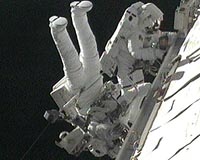 |
Washington (AFP) Aug 2, 2010 NASA teams raced Monday to get ready for two challenging spacewalks to fix a pump module on the International Space Station's cooling system that dramatically failed last week. ISS astronauts will need a minimum of two spacewalks to remove the failed ammonia pump unit and replace it with a new one, with the first to take place on Friday, NASA said. Two astronauts held dry-runs for the spacewalks at the Neutral Buoyancy Laboratory (NBL) in Houston, where they choreographed what needed to be done outside the ISS and worked out how long it might take. After practicing the steps needed to remove and replace the failed unit, NASA gave the green light to ISS astronauts Doug Wheelock and Tracy Caldwell Dyson to start the first spacewalk on Friday. "Mission managers, program managers, flight controllers, engineers, astronauts and spacewalk experts made the decision Monday evening after continuing to analyze and refine engineering requirements, and reviewing the results of an underwater practice session," NASA said on its website. Courtenay McMillan, the spacewalk flight director for the expedition, earlier told reporters the first spacewalk could take place on Thursday. The first spacewalk will focus on getting the failed unit out of the starboard truss on the ISS, which poses a few technical challenges including releasing lines that are pressurized with ammonia which is usually pumped into the cooling system, when the module is working, said McMillan. Once the failed unit has been removed, the two astronauts will have to move a 780-pound (355 kilograms) spare unit around 30 feet (10 meters) from the opposite side of the truss for insertion into the gap left by by the defective pump module. "This is a big, unwieldy object, so maneuvering it around and handing it off to crewmembers... could take some time and a lot of focus," said McMillan. The crew faces a very tight lead time for such a tricky spacewalk -- less than a week when NASA usually takes two weeks to prepare for a spacewalk to fix a "Big 14 failure," when a major unit stops working. The cooling pump going down was a "Big 14 failure, said Mike Suffredini, manager of the ISS program, but NASA was prepared for it. "This is an anomaly we knew someday would happen. It's an anomaly we've trained for, it's an anomaly we've planned for, it's obviously one we've spared for. So we're in a good position to solve this problem," said Suffredini. "But it is a significant failure, in terms of systems on board ISS. So it's one that we have to get after." If the second of the two ISS cooling units were to fail -- a highly unlikely scenario, according to Suffredini -- then the astronauts on board the ISS would no longer be able to cool most of the components on board the space station. The crew would not be in immediate danger, however, as they could move to the Russian segment of the ISS, which has its own cooling system. Astronauts tried after Saturday's failure to reactivate the pump module, but the circuit breaker tripped, said Suffredini. "The data suggest that the motor is not frozen. In fact, it did start to pump some of the ammonia when we tried to start it the second time. So this tells us that there's a short somewhere in the powerfeed of the motor."
Share This Article With Planet Earth
Related Links Station at NASA Station and More at Roscosmos S.P. Korolev RSC Energia Watch NASA TV via Space.TV Space Station News at Space-Travel.Com
 NASA plans two challenging spacewalks to fix ISS pump
NASA plans two challenging spacewalks to fix ISS pumpWashington (AFP) Aug 2, 2010 NASA teams raced Monday to get ready for two challenging spacewalks to fix a pump module on the International Space Station's cooling system that dramatically failed last week. ISS astronauts will need a minimum of two spacewalks to remove the failed unit and replace it with a new one, and teams on the ground and in space were racing to do the first of the spacewalks on Thursday, Courtenay M ... read more |
|
| The content herein, unless otherwise known to be public domain, are Copyright 1995-2010 - SpaceDaily. AFP and UPI Wire Stories are copyright Agence France-Presse and United Press International. ESA Portal Reports are copyright European Space Agency. All NASA sourced material is public domain. Additional copyrights may apply in whole or part to other bona fide parties. Advertising does not imply endorsement,agreement or approval of any opinions, statements or information provided by SpaceDaily on any Web page published or hosted by SpaceDaily. Privacy Statement |